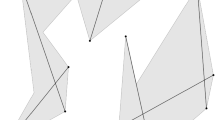Abstract
Skeletonization of polygons is a technique, which is often applied to problems of cartography and geographic information science. Especially it is needed for generalization tasks such as the collapse of small or narrow areas, which are negligible for a certain scale. Different skeleton operators can be used for such tasks. One of them is the straight skeleton, which was rediscovered by computer scientists several years ago after decades of neglect. Its full range of practicability and its benefits for cartographic applications have not been revealed yet. Based on the straight skeleton an area collapse that preserves topological constraints as well as a partial area collapse can be performed. An automatic method for the derivation of road centerlines from a cadastral dataset, which uses special characteristics of the straight skeleton, is shown.















Similar content being viewed by others
References
T. Ai and P. van Oosterom. “Gap-tree extensions based on skeletons,” in D. Richardson and P.J.M. van Oosterom (Eds.), Advances in Spatial Data Handling, 10th International Symposium on Spatial Data handling, 501–513, 2002.
O. Aichholzer, F. Aurenhammer, D. Alberts, and B. Gärtner. “A novel type of skeleton for polygons,” J.UCS: Journal of Universal Computer Science, Vol. 1(12):752–761, 1995.
M. Bader and R. Weibel. “Detecting and resolving size and proximity conflicts in the generalization of polygonal maps,” in Proceedings of 18th International Cartographic Conference, Stockholm, Sweden, pp. 1525–1532, 1997.
F.Y. Chin, J. Snoeyink, and C.A. Wang. “Finding the medial axis of a simple polygon in linear time,” in ISAAC ’95: Proceedings of the 6th International Symposium on Algorithms and Computation, pp. 382–391, Springer-Verlag, 1995.
R. Chithambaram, K. Beard, and R. Barrera. “Skeletonizing polygons for map generalization,” in Technical papers, ACSM-ASPRS Convention, Cartography and GIS/LIS, Vol. 2, 1991.
D. Eppstein and J. Erickson. “Raising roofs, crashing cycles, and playing pool: applications of a data structure for finding pairwise interactions,” in SCG ’98: Proceedings of the Fourteenth Annual Symposium on Computational Geometry, pp. 58–67, 1998.
P. Felkel and Š. Obdržálek. “Straight skeleton implementation,” in Proceedings of Spring Conference on Computer Graphics, Budmerice, Slovakia, pp. 210–218, 1998.
R.C. Gonzalez and R.E. Woods. Digital Image Processing. 2nd edition, Addison-Wesley Publishing Company, 2002.
N. Haala and C. Brenner. “Generation of 3d city models from airborne laser scanning data,” in Proceedings of 3rd EARSeL Workshop on Lidar Remote Sensing of Land and Sea, Tallinn, Estonia, 1997.
F. Penninga, E. Verbree, W. Quak, and P. van Oesterom. “Construction of the planar partition postal code map based on cadastral registration,” GeoInformatica, Vol. 9(2):181–204, 2005.
S.A. Roberts, G. Brent Hall, and B. Boots. “Street centerline generation with an approximated area voronoi diagram,” in P.F. Fisher (Ed.), Developments in Spatial Data Handling, 11th International Symposium on Spatial Data Handling, 435–446, 2004.
B. Su, Z. Li, and G. Lodwick. “Morphological models for the collapse of area features in digital map generalization,” GeoInformatica, Vol. 2(4):359–382, 1998.
M. Tănase and R.C. Veltkamp. “A straight skeleton approximating the medial axis,” in S. Albers and T. Radzik (Eds.), Proc. 12th Eur. Symp. Algorithms (ESA 2004), number 3221 in Lecture Notes in Computer Science, pp. 809–821, Springer-Verlag, 2004.
P. van Oosterom. “The gap-tree, an approach to ‘on-the-fly’ map generalization of an area partitioning,” in J.-C. Müller, J.-P. Lagrange, and R. Weibel (Eds.), GIS and Generalization - Methodology and Practice, number 1 in GISDATA, chapter 9, pp. 120–132, Taylor & Francis, 1995.
Acknowledgements
This work shows results of the project entitled ‘Updating of Geographic Data in a Multiple Representation Database’. The project is funded by the German Research Foundation (Deutsche Forschungsgemeinschaft). It is part of the bundle-project entitled ‘Abstraction of Geographic Information within Multi-Scale Acquisition, Administration, Analysis and Visualization’.
Author information
Authors and Affiliations
Corresponding author
Rights and permissions
About this article
Cite this article
Haunert, JH., Sester, M. Area Collapse and Road Centerlines based on Straight Skeletons. Geoinformatica 12, 169–191 (2008). https://doi.org/10.1007/s10707-007-0028-x
Received:
Revised:
Accepted:
Published:
Issue Date:
DOI: https://doi.org/10.1007/s10707-007-0028-x




